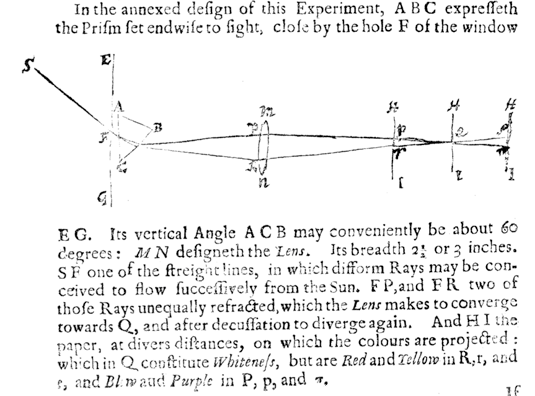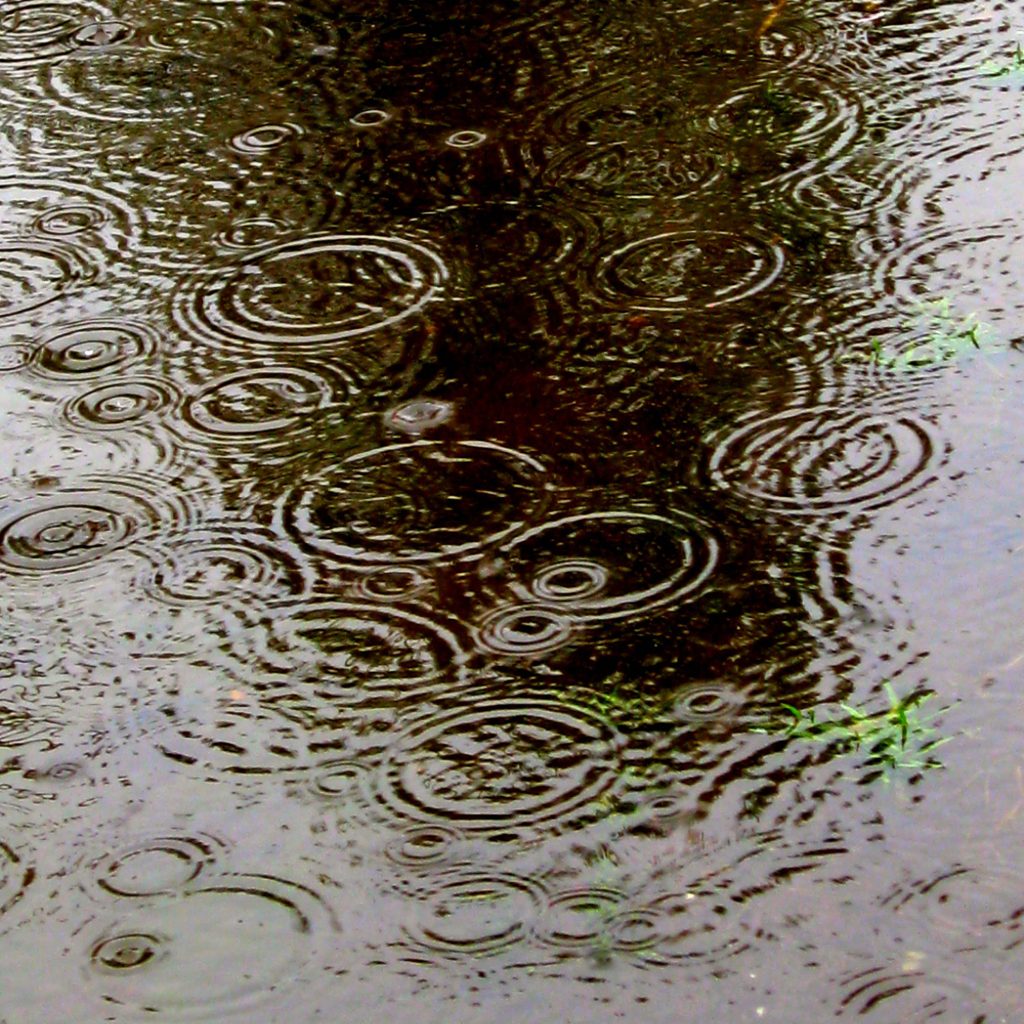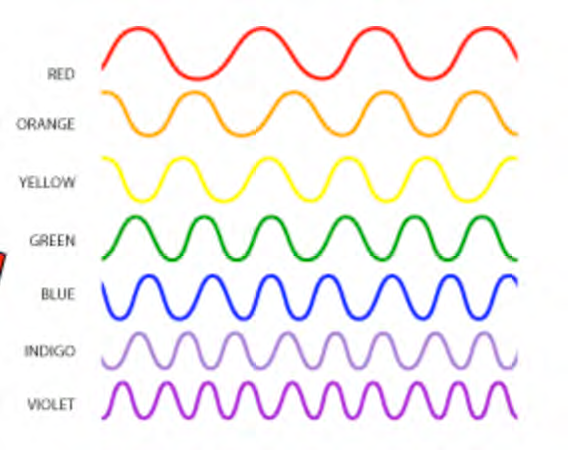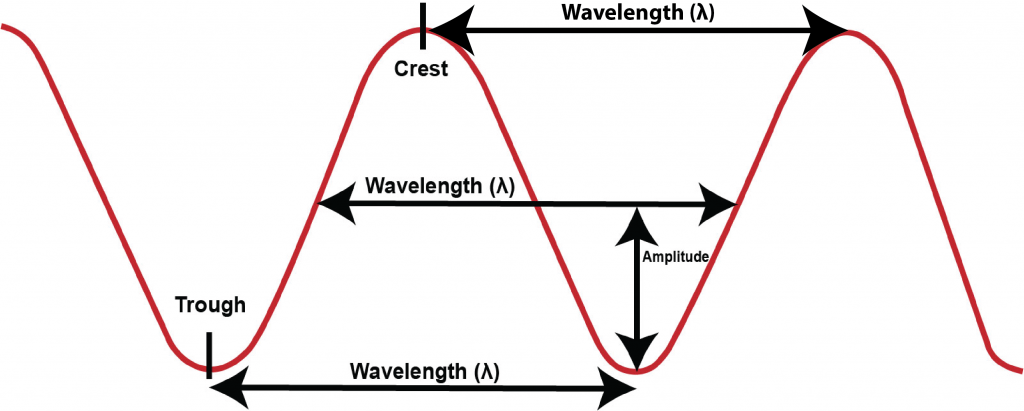Unit 1: Exploring the Nature of Light Phenomena
IX. Historical and Current Perspectives on the Nature of Light
Historical interpretations of the spectrum of colors dispersed by a prism
Archeologists have found glass prisms in ancient Roman ruins as well as natural prisms such as rock crystals in Pompeii (Rossi & Russo, 2017, p. 335). These findings suggest that people have been seeing a spectrum of colors displayed when white light shines through a prism since ancient times. Greek and Roman writers also discussed optical phenomena. Euclid (325 BC-265 BC), for example, envisioned light as rays moving in straight lines, formulated a law of reflection, and knew about refraction effects (Mach, 1926/2003, p. 3-4).
People also have pondered the nature of light and colors for a long time. The Greek philosopher Aristotle (384 BC-322 BC), for example, wrote that colors were mixtures of light (white) and darkness (black). This became widely accepted and led to the view that light from the Sun was a single form of light, white, and that a prism modified pure white light into the different colors as the white light moved through the prism.
This view of white light persisted until the publication of a letter to the Royal Society of London in 1671/72 by Isaac Newton. He stated and supported a different view, that white light was already a mixture of colors, with each color bending as it entered a prism at its own angle of refraction.
Newton (1671/72) referred to refraction as “refrangibility” and stated that:
As the Rays of light differ in degrees of Refrangibility, so they also differ in their disposition to exhibit this or that particular colour…The least Refrangible Rays are all disposed to exhibit red colour, and contrarily those Rays, which are disposed to exhibit a Red colour, are all the least refrangible: So, the most refrangible Rays are all disposed to exhibit a deep Violet Colour, and contrarily those which are apt to exhibit such a violet colour, are all the most Refrangible. And so to all the intermediate colours in a continued series belong intermediate degrees of refrangibility. (p. 3081, #1 and #2) https://royalsocietypublishing.org/doi/abs/10.1098/rstl.1671.0072
In addition, Newton noted that when we perceive an object to have a particular color, that effect is due to the object primarily reflecting light of that color to our eyes:
…the Colours of all natural Bodies have no other origin than this, that they are variously qualified to reflect one sort of light in greater plenty than another. And this I have experimented in a dark Room by illuminating those bodies with uncompounded light of divers colours…and consequently when illuminated with day-light, that is, with all sorts of Rays of any colour promiseuously blended, those qualified with red shall abound most in the reflect light, and by their prevalence cause it to appear of that colour (ibid, p. 3084-3085, #13)
Newton claimed that the colored rays already existed within the white light and that these rays separate as they bend at different angles within the prism (p. 3083, #7). To support this claim, Newton showed that not only did a prism disperse white light into separate colors but also that a lens could converge these colored rays back into white light like that that comes from the Sun. He presented evidence for this claim by describing his experimental setup and findings:
In a darkened room make a hole in the shut of a window, whose diameter may conveniently be about third part of an inch, to admit a convenient quantity of the Suns light: And there place a clear and colourless Prisme, to refract the entering light towards the further part of the Room, which, as I said, will thereby be diffused into an oblong coloured Image. Then place a Lens of about three-foot radius (suppose a broad Object-glass of a three foot Telescope,) at the distance of about four or five foot from thence, through which all those colours may at once be transmitted, and made by its Refraction to convene at a further distance of about ten or twelve feet. If at that distance you intercept this light with a sheet of white paper, you will see the colours converted into whiteness again by being mingled.
He provided some details of how to do this and suggestions of what to observe:
But it is requisite, that the Prisme and Lens be placed steddy, and that the paper, on which the colours are cast, be moved to and fro; for, by such motion, you will not only find, at what distance the whiteness is most perfect, but also see, how the colours gradually convene, and vanish into whiteness, and afterwards having crossed one another in that place where they compound Whiteness, are again dissipated, and severed, and in an inverted order retain the same colours, which they had before they entered the composition…(ibid., p. 3086)
Newton also provided the ray diagram reproduced in Figure 1.51 to illustrate this experiment. In Figure 1.51, rays of white light from the sun (SF) enter a hole in a window (EG), pass through an equilateral prism (ABC), and are dispersed, with example rays FP bent more than FR. Lens (mn) converges these rays so that they meet at point Q on paper HI as white light, although they are seen as colored spots before and after Q if the paper HI is moved back and forth. (This excerpt from the letter also includes some of the text, in which the font for s looks like an f.)

https://royalsocietypublishing.org/doi/abs/10.1098/rstl.1671.0072
Newton also applied this understanding to explain the colors in the rainbow (#10 on pages 3083-3084). We too can use what we now know about reflection, refraction, and dispersion to make sense of why we sometimes can see beautiful rainbows in the sky.
References in this section:
Newton, I. (1671/72). A letter of Mr. Isaac Newton, Professor of the Mathematics in the University of Cambrdige; Containing his new theory about light and colors: Sent by the author to the publisher from Cambridge, Febr. 1671/72; in order to be communicated to the R. Society. Philosophical transactions of the Royal Society of London, 6, (60-80) 3075-3087. https://royalsocietypublishing.org/doi/abs/10.1098/rstl.1671.0072
For information about this letter and its problematic reception at the time, see Patricia Fara’s article celebrating the 350th anniversary of the journal Philosophical Transactions of the Royal Society:
Fara, P. (2015). Newton shows the light: a commentary on Newton (1672) ‘A letter…containing his new theory about light and colors…’ Philosophical Transactions of the Royal Society, http://rsta.royalsocietypublishing.org/content/373/2039/20140213.
Other references mentioned in this section:
Ernst Mach, The principles of physical optics: an historical and philosophical treatment. Trans. J. S. Anderson and A.F.A. Young. (Methuen & Co, London; Dover, Mineola, NY, 1926/2003).
Cesare Rossi and Flavio Russo, Ancient Engineers’ Inventions: Precursors of the Present. (2nd ed.) Cham, Switzerland: Springer International, p. 335. (2017). ISBN 978-3-319-44476-5
Library of Universal Knowledge, A Reprint of the Last (1880) Edinburgh and London Edition of Chambers’s Encyclopaedia, p. 731
https://play.google.com/store/books/details?id=ichZAAAAYAAJ&rdid=book-ichZAAAAYAAJ&rdot=1
https://play.google.com/books/reader?id=ichZAAAAYAAJ&printsec=frontcover&output=reader&hl=en&pg=GBS.PA731 p. 731
In addition to referring to light as rays, Newton envisioned rays as composed of “small particles”. In a later major document summarizing his exploration of light phenomena, the book Opticks, he wrote:
Are not the Rays of Light very small Bodies emitted from shining Substances? (p. 371, Question 29)
Newton, I. (1730). Opticks: Treatise of the Reflections, Refractions, Inflections and Colours of Light. (4th ed.) London: William Innys at the Westend of St. Paul’s . http://www.gutenberg.org/ebooks/33504
Christiaan Huygens (1690), a Dutch contemporary of Newton, however, proposed an alternative way of envisioning light, as analogous to sound, traveling outward in all directions from a source like a wave formed when a pebble drops into a puddle of water:
It (light) spreads, as Sound does, by spherical surfaces and waves: for I call them waves from their resemblance to those which are seen to be formed in water when a stone is thrown into it, and which present a successive spreading as circles, though these arise from another cause, and are only in a flat surface.(p. 4)
Christiaan Huygens, Treatise on Light. (Translated from French by Silvanus P Thompson). Macmillan, London, 1690/1912). http://www.gutenberg.org/ebooks/14725
Figure 1.52 shows examples of successive spreading of circles from raindrops falling on water.

https://www.flickr.com/photos/ruthanddave/5713878850
Envisioning light as such successive spreading of circular waves also occurs today. Light waves can be represented as shown in Figure 1.53, which presents the primary colors of the spectrum of light from the sun. Red light has the largest wavelength, violet the smallest.

National Aeronautics and Space Administration, Science Mission Directorate. (2010). Visible Light. http://science.nasa.gov/ems/09_visiblelight , accessed May 28, 2019.
As shown in Fig. 1.54, a wave length, often represented by the Greek letter lambda can be measured from crest to crest, midpoint to midpoint, or trough to trough. The wave’s amplitude is the distance from the midpoint to the crest or trough.

The light’s frequency, often represented by f or the Greek letter nu is the number of waves that pass a point each second. The speed of a wave depends on both the wavelength and the frequency: [latex]\text{(speed)} = \text{(wavelength)(frequency)}[/latex].
These two perspectives on what light IS, whether particles or waves, were evident in the writings of Newton and Huygens in the 17th century. They continue today in the “wave-particle duality’’ to which physicists refer. Sometimes it is helpful to think of light as a stream of particles, sometimes as a spreading wave. Each perspective is useful, depending upon the context within which one is asking questions about light.

